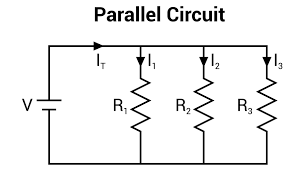What is a Parallel Circuit?
In the realm of electrical engineering, parallel circuits stand as one of the fundamental configurations in which components are interconnected. Unlike series circuits, where components are arranged in a single path, parallel circuits offer multiple pathways for current flow. In this arrangement, each component is connected across the same voltage source, allowing for independent operation.

What is the Difference Between Series and Parallel?
Series and parallel circuits represent two distinct ways of connecting electrical components. In a series circuit, components are linked end-to-end, forming a single pathway for current flow. This means that the same current flows through each component. In contrast, parallel circuits feature multiple branches, enabling independent pathways for current flow. Components in parallel circuits share the same voltage across them. Helpful resource: https://byjus.com/physics/difference-between-series-and-parallel-circuits/#:~:text=In%20a%20series%20circuit%2C%20the,circuit%20splits%20the%20current%20flow.
How Do You Know if a Circuit is Parallel or Series?
Distinguishing between parallel and series circuits is crucial for understanding the behavior of electrical systems. A circuit is deemed parallel if it contains multiple branches, with each branch providing an alternative path for current. Conversely, a circuit is considered series if components are connected end-to-end, forming a single pathway for current flow. Understanding this distinction enables engineers to analyze and design circuits effectively. Helpful resource: https://m.youtube.com/watch?v=7_HFMoOkJDg
What is a Parallel Circuit in Real Life Example?
Parallel circuits find widespread application in various real-life scenarios, showcasing their practical significance. An illuminating example can be found in household lighting systems. In typical lighting setups, multiple light bulbs are connected in parallel across the same voltage source. This configuration ensures that each bulb operates independently, allowing for individual control without affecting the brightness of other bulbs. It exemplifies the versatility and efficiency of parallel circuits in everyday applications. Helpful resource: https://www.inspiritvr.com/parallel-circuits-study-guide/#:~:text=The%20parallel%20circuit%20examples%20are,Home%20wiring
How Do I Make a Parallel Circuit?
Creating a parallel circuit involves interconnecting electrical components in a specific manner to facilitate multiple pathways for current flow. To construct a parallel circuit, follow these steps:
-
Identify Components: Determine the electrical components to be included in the circuit, such as resistors, light bulbs, or appliances.
-
Gather Materials: Collect necessary materials, including wires, a power source (such as a battery or power supply), and the chosen components.
-
Wire Connection: Connect each component to the power source using separate branches of wire. Ensure that all components are linked in parallel, with each having its own pathway to the power source.
-
Check Connections: Verify that all connections are secure and properly insulated to prevent short circuits or electrical hazards.
-
Test Circuit: Apply power to the circuit and observe the behavior of individual components. Confirm that each component operates independently and shares the same voltage across them.
By following these steps, you can successfully construct a parallel circuit tailored to your specific application, harnessing its benefits of reliability, redundancy, and individual component control. Helpful resource: https://pressbooks.bccampus.ca/basicelectricity/chapter/ground/#:~:text=A%20parallel%20circuit%20is%20constructed,voltage%20appears%20across%20each%20component.&text=The%20voltage%20across%20each%20branch%20is%20the%20same.
In conclusion, parallel circuits play a vital role in electrical engineering, offering versatile solutions for diverse applications. Understanding their principles, distinctions from series circuits, real-life examples, and construction methods empowers engineers and enthusiasts alike to harness the advantages of parallel configurations in their projects.
Facts Checked by Hugh Johnson
Hugh Johnson stands tall in the realms of both the chip industry and the electronic parts industry, earning acclaim as an esteemed expert in these fields. With an extensive background steeped in semiconductor technology, Hugh's expertise transcends chip design and fabrication, encompassing a profound understanding of electronic components' intricate functionalities and applications. His seasoned knowledge spans diverse facets, from microchip architecture and fabrication techniques to the broader landscape of electronic parts utilized across industries.









